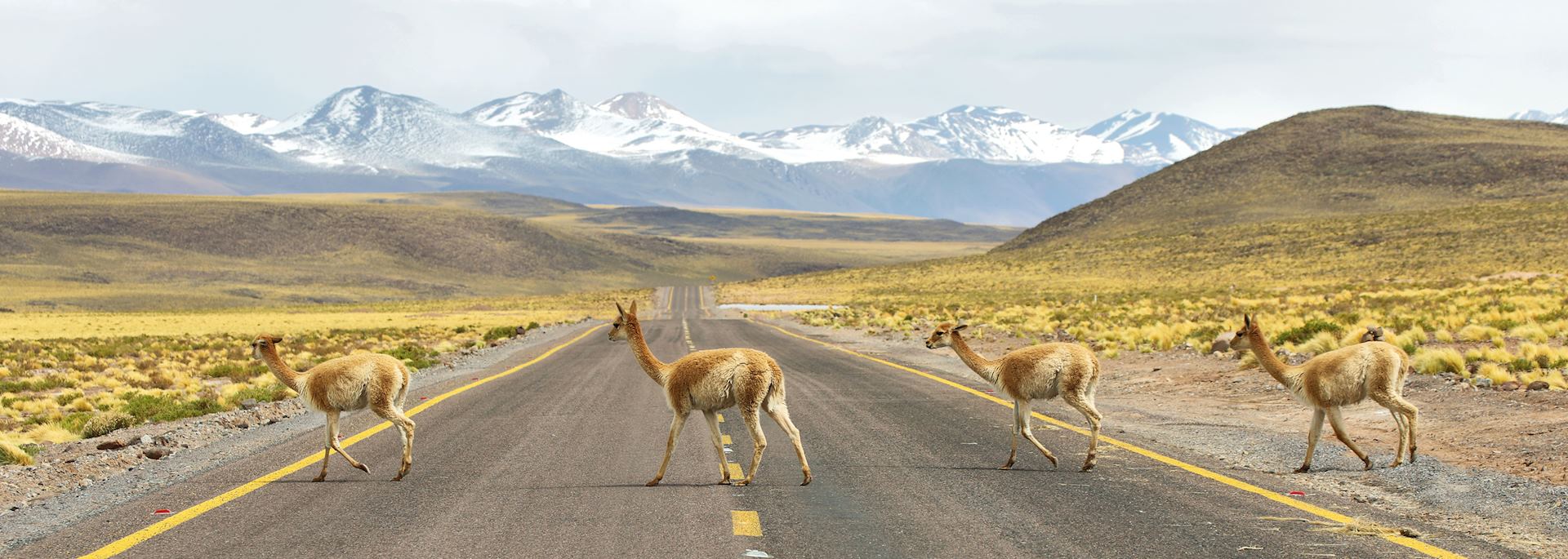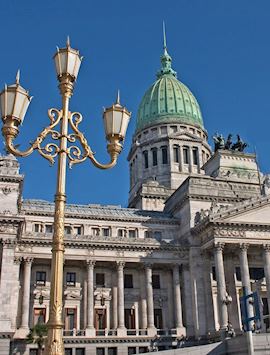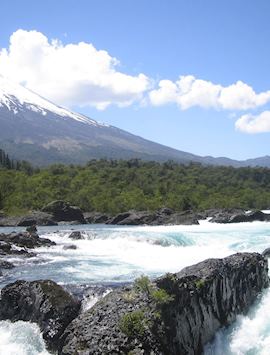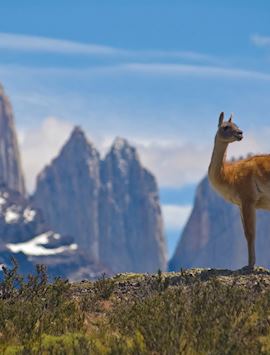By Audley Chile specialist Nick
The vast open wildernesses, easy roads and pleasant driving conditions of Chile and Argentina lend themselves to the freedom and adventure of a self-drive trip.
It would be impossible to cover the highlights of both countries in one trip given the distances involved. A two-week trip might, for instance, uncover the Lake Districts of Chile and Argentina, with a sojourn into the Chilean wine district at the beginning of your route.
Alternatively, you could spend time discovering Patagonia on both the Chilean side and in Argentina. More off-the-beaten-track options would include the Aysén region in Chile, or Northwest Argentina.
With many of the regions of both countries divided by the southern Patagonia ice field or the high peaks of the Andes, you will often need to fly to continue your driving route. So you can drop off your hire car at one airport and collect another at your next destination.
Drive around Chile and Argentina鈥檚 Lake Districts
Discover the Central Wine Region

After arriving in Chile’s capital, Santiago, a few days exploring the Central Wine Region will allow you to start your trip on a relaxed note. The Casablanca Valley, just a 45-minute drive from Santiago, and the Colchagua Valley, two hours' drive south, produce many of the wines found on the supermarket shelves in other countries. Being able to sample a rich merlot surrounded by the original vines was a highlight of my trip.
The Casablanca Valley combines well with Valparaíso, a historical seaport city of houses painted in bold reds, blues, greens and golds dotted around a hillside. My suggestion would be to drive here from Santiago and then travel on to Casablanca for a couple of nights’ stay on a vineyard.
This gives you the freedom to explore the wine region at your own pace, enjoying leisurely hillside lunches and taking tours of the vineyards as and when you choose.
Self-driving in the Chilean Lake District

The Lake Districts of both Argentina and Chile are especially good for self-driving, with a variety of routes, easy navigation, and well-developed roads.
Depending on time constraints, you may choose to base yourself in the Northern or Southern Lake Districts of either country, taking day trips to see the region. Alternatively, either country’s Lake District can be explored by driving from north to south, with a few overnight stops. Where you have more time, coupled with a sense of adventure, a circular route of both countries opens up more remote areas.
With active volcanoes, hot springs, and the eponymous lakes, the Chilean Lake District is an open-air pleasure ground for cycling, fishing, boat trips and trekking. Away from the main hubs of Pucón and Puerto Varas, visitors are a rarity, as I found when I drove down the Pan-American Highway, stumbling across remote villages.
At one village I stopped for directions and found myself giving a lift to a local man who pointed me in the direction of a fantastic viewpoint overlooking Lago Calafaquén, a sight that I’d never have found alone.
Crossing the border to explore the Argentina Lake District

From the Chilean Lake District, you can cross the border into Argentina. I drove along the famous ‘Route of the Seven Lakes’. Journeying south, a backdrop of glacier-clear lakes fringed with forested hillsides slowly gave way to dramatic mountain peaks, and having a car meant that I could stop at any point to enjoy the scenery from numerous viewpoints.
Staying in Villa la Angostura, a resort halfway along the route, gives you the time to discover each lake. This is a journey that, when done in its entirety, takes six hours so the area is easily explored from one central location.
Alternatively, another great route in this area takes the form of a horseshoe loop. Flying into Temuco, Chile, you drive for an hour and a half to Pucón, stopping off to view or climb the showstopper stratovolcano Villarrica, its smoking cone often sheathed in snowfall.
From there, you cross the border into Argentina to the lakeside town of San Martín de los Andes, continuing onto San Carlos de Bariloche and Villa la Angostura before looping back into Chile via Puerto Varas.
It’s a good way of seeing the spectrum of scenery in this part of the world. Chile owns the volcanoes and mountains, and consequently the rainfall, making its lower valleys of its Lake District rich and fertile. The Argentine side is somehow wilder and the green of the hills gives way rapidly to the brown of the Patagonian steppe. It’s Switzerland meets the Wild West.
The whole loop takes about six to seven days to drive.
Patagonia by car
Discover the steep peaks of Torres del Paine

The dramatic mountain scenery of Chile鈥檚 main national park, in my opinion, eclipses other regions of the country with its glaciers, lakes, snow-capped mountains and granite rock formations eroded into shape over millions of years.
You can access this area by flying into Punta Arenas in Chilean Patagonia, where you collect your hire car and drive to Torres Del Paine, passing through the city of Puerto Natales.
Basing yourself in one of the hotels in the national park and spending a few days driving around is my preferred way to see the countryside. It also affords the freedom to try out some of the many treks in the region, which can take anything from a few hours to several days.
The Lago Grey Glacier can also be visited from here, where you can watch the electric blue blocks of ice occasionally crashing into the lake and the more regular sight of them floating toward Rio Grey.
Driving around Argentinean Patagonia

To cross the border from Torres Del Paine into Argentinean Patagonia, I recommend taking an overland road transfer as you can’t drop off your hire car in a different country without paying an exorbitant premium. Alternatively, you could return to Punta Arenas and take a boat trip from there, around Cape Horn to Ushuaia in Argentina. Cruising through the fjords, past penguin colonies and glaciers, makes this mode of transport an exceptional way to cross the border.
Once in El Calafate in Argentinean Patagonia, you’re well located to explore the mighty Perito Moreno Glacier. The best way to do this is on a boat trip that sails across the face of the glacier, and there's also the option of a shorter boat ride to its edge from where you can trek on the ice sheet itself.
Driving a couple of hours north from here you reach El Chalt茅n, the trekking capital of the region and a base from which to explore the Fitzroy Massif. There are many different routes, and the hotels supply maps of the trails, so you won’t need a guide.
I particularly like the full day trek to Laguna de los Tres, a 27 km (17 mile) round trip from El Chalt茅n to the base of the mountains. The region is suitable for most walkers, with good paths and fairly gentle inclines, and just a bit of scrambling on one of the trails.
More off-the-beaten-track self-drives
Explore the glaciers and mountains of the Ays茅n region
.jpg?q=79&w=800&h=266)
Chile’s southernmost point before the impenetrable Southern Patagonian ice fields, the Ays茅n region of Chile is less developed with fewer hotels but this is more than compensated for by the scenery: the serrated line of the ice-capped Andes, winding rivers, forests and valleys. I spent three months there and saw only a handful of other visitors.
The best way to access the region is by flying into Balmaceda. Here you can collect your car before driving down as far as Caleta Tortel, should you wish, a tiny village built on wooden walkways above the green water of an inlet, a place to both visit and stay in.
This is a long journey, and you will need to stop en route. If this sounds too demanding, you can head only as far south as the Parque Patagonia, a private reserve that you can access freely.
As you drive, the scenery shifts from evergreen forest and glacial lakes to fast flowing rivers and the desert landscape of the Patagonian Steppe. For me, it’s as good as anything you’ll see in Torres del Paine, but it receives hardly any visitors.
Walking, trekking and cycling are ideal ways to experience this region to its fullest. It is also one of the best fly-fishing regions in Chile, with trout as the main catch. The fishing high season runs from September to March, and you don’t need a permit if you fish through a lodge.
Marble caves, their pristine white walls contrasted against the turquoise blue of the lakes, can be explored on a boat trip through the cathedral-like chambers, which were carved out by water draining into the Pacific. You can also see exquisite hanging glaciers from the road, or up close on a small motorboat between November and March.
Self-driving in northwest Argentina

The salt flats, vineyards, gorges, mountains, and colonial cities of northwest Argentina make this one of the parts of the country I most enjoy revisiting for its sheer diversity of activities and landscapes.
In the dry season, from April to mid-November, driving in this region is relatively easy, though a 4x4 is a necessity if you want to explore properly. Again, there’s the option to base yourself in one place — the leafy conquistador city of Salta, which is also your entry point into this region — and take day trips to explore the surrounding landscapes.
As with so much of Chile and Argentina, the drive will take you through ever-changing scenery. The greenery surrounding Salta gives way to dusty desert towns and then to the salt flats, gorges and ‘Cerro de los Siete Colores’, the mountain ranges around Purmamarca composed of stripes of rock in shades of russets, terracotta and pale yellows. Driving independently in this area affords you the opportunity to linger over these remarkable views.
The area north of Salta, stretching across the very northwest corner of the country, is known as the Puna. This region of plains, valleys and barren grasslands is even higher than Chile’s Atacama Desert (at 4,800 m (15,748 ft) above sea level). It also has some of the most entrancing, outlandish scenery I’ve ever seen in all my travels across South America: red dunes, salt flats, white rock formations that look like they’ve been twisted by the hand of the devil, and lunar-like plateaus.
The best way of exploring it all is actually to relinquish the driving to a private driver-guide, who’ll take you around the challenging, unpaved roads by 4x4. Be prepared for long days in the car, and to stay in tiny, out-of-the-way villages in simple lodgings.
Driving Ruta 40 from Salta to Mendoza

This road, Argentina鈥檚 answer to Route 66, is 5,000 km (3,110 miles) long. It stretches from the top end of the Humahuaca Gorge, near Jujuy, all the way to Ushuaia, last stop before Antarctica.
This northwest section of it, starting in Salta and ending in the fertile wine regions of Mendoza Province, amounts to just under a third of the whole road. It takes around five or six days to drive.
It鈥檚 a journey into the Argentina that most visitors barely see: high-drama geology in a landscape that鈥檚 largely undeveloped and certainly not commercial, and very far from the quasi-European ambience of Buenos Aires.
You drive past crater lakes, salt flats and red-rock canyons, and have the chance to stop off at national parks, some of which contain eminent paleontological discoveries of recent years.
And, indeed, there are swathes of road, such as the section known as the Cuesta de Miranda, where it鈥檚 all too easy to imagine yourself back in the age of the dinosaurs. You drive for hours surrounded by nothing but a scorched landscape of rust-red rocky outcrops, with no signs of human habitation in sight.
Practicalities of self-driving in Chile & Argentina
- Although you don’t need a 4x4, we normally recommend it for comfort.
- It's important to fill up with fuel whenever you can, as the distance to the next fill-up point can be huge.
- In Chile and Argentina, you drive on the right hand side of the road.
Start planning your self-drive trip to Chile & Argentina
Start thinking about your experience. These itineraries are simply suggestions for how you could enjoy some of the same experiences as our specialists. They're just for inspiration, because your trip will be created around your particular tastes.
View All Tours in South AmericaFurther reading
- Self-drive holidays in Chile: 3 wilderness road trips
- Driving Argentina鈥檚 wild northwest: Salta to Mendoza on Ruta 40
- What to do in Patagonia: our highlights guide
- How to spend two weeks in Argentina's Lake District
- More Audley self-drive trips
- Self-drive holidays in Chile: 3 wilderness road trips
- Best time to visit Chile
- Best time to visit Argentina
- More Audley self-drive trips




